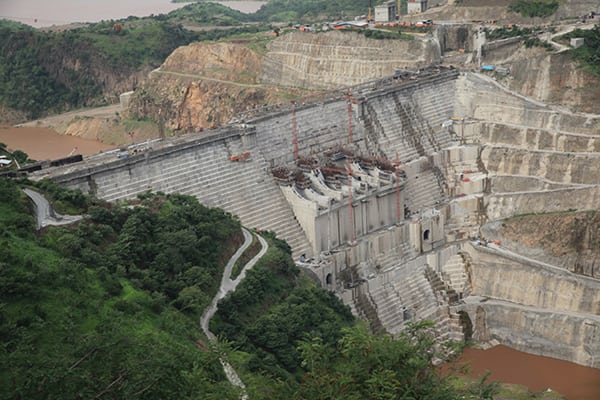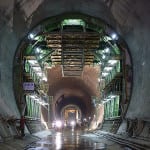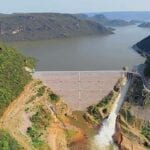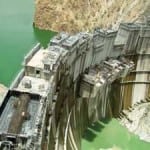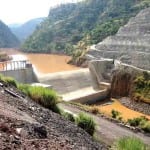Ethiopia’s generation capacity got an immense boost as operations began at the 1.87-GW Gibe III hydroelectric power plant in the middle reach of the Omo River basin this October. The plant—Ethiopia’s largest—is the third in the Gibe-Omo hydroelectric cascade, which includes the 184-MW Gilgel Gibe and 420-MW Gibe II, both upstream of Gibe III. Two additional plants downstream, Gibe IV and Gibe V, are planned by state-owned utility Ethiopian Electric Power Corp.
According to Salini Impregilo, an Italian firm contracted to build the $1.6 billion project, the plant comprises a 249-meter (m)-tall roller-compacted concrete (RCC) dam—one of the highest in the world—and an open-air power plant with 10 Francis turbines. It is expected to produce 6,500 GWh per year (Figure 1).
Salini Impregilo designed and built the plant and the gravity dam, along with a surface spillway. It also carved out three diversion tunnels, two twin pumping tunnels, two intake structures, two horizontal tunnels, four vertical wells, and two distributors. Consulting engineering firm Studio Pietrangeli performed the feasibility study, designed the plant, and provided technical supervision during construction.
Construction began in July 2006. For Salini Impregilo, many of the challenges in building the dam came from logistical hurdles, specifically because the site—about 450 km southwest of Ethiopia’s capital, Addis Ababa—is so remote. Access to it required building an airport, a 120-m span bridge, 75 km of new national roads, and 40 km of project site roads. The firm then needed to provide workers with housing, sanitation, health, and recreation facilities.
Then, when crews began foundation excavation, they encountered hot springs that required interception. Later, crews discovered that locally sourced Ethiopian cements were unsuitable because of variability in quality and intermittent supply, leading the government to step in to open up the importation of special high-quality cement. And because the RCC dam is one of the highest in the world and the site did not offer ideal conditions for the project, special design solutions were required. Despite those geological issues as well as complex financial problems, the plant was completed within nine years.
With a rainy season that lasts three to four months, mountainous Ethiopia is etched with large river gorges that have an overall hydroelectric potential estimated at around 160 TWh/year. This country with a population of 94.1 million and a booming economy has ambitious plans under its Growth and Transformation Plan to become a regional renewable energy hub in power-strapped East Africa. The Gibe III project added much-needed capacity to the country’s total installed 2.3-GW base.
By 2037, Ethiopia aspires to have a total capacity of 37 GW (a 1,500% increase) and become a major power exporter. Acknowledging that the feat will require massive investments, the government is committed to increasing private sector participation to expand its grid and to reform tariffs to allow for full-cost recovery.
—Sonal Patel, associate editor


